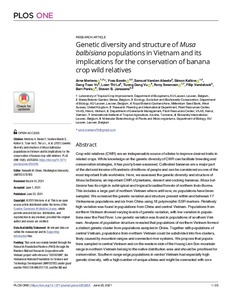| dc.contributor.author | Mertens, A. |
| dc.contributor.author | Bawin, Y. |
| dc.contributor.author | Abeele, S.V. |
| dc.contributor.author | Kallow, S. |
| dc.contributor.author | Vu, D.T. |
| dc.contributor.author | Le, L.T. |
| dc.contributor.author | Vu, T.D. |
| dc.contributor.author | Swennen, R. |
| dc.contributor.author | Vandelook, F. |
| dc.contributor.author | Panis, B. |
| dc.contributor.author | Janssens, S. |
| dc.date.accessioned | 2021-07-16T12:52:31Z |
| dc.date.available | 2021-07-16T12:52:31Z |
| dc.date.issued | 2021 |
| dc.identifier.citation | Mertens, A., Bawin, Y., Abeele, S.V., Kallow, S., Vu, D.T., Le, L.T., ... & Janssens, S.B. (2021). Genetic diversity and structure of Musa balbisiana populations in Vietnam and its implications for the conservation of banana crop wild relatives. PLOS ONE, 16(6), e0253255: 1-22. |
| dc.identifier.issn | 1932-6203 |
| dc.identifier.uri | https://hdl.handle.net/20.500.12478/7183 |
| dc.description.abstract | Crop wild relatives (CWR) are an indispensable source of alleles to improve desired traits in related crops. While knowledge on the genetic diversity of CWR can facilitate breeding and conservation strategies, it has poorly been assessed. Cultivated bananas are a major part of the diet and income of hundreds of millions of people and can be considered as one of the most important fruits worldwide. Here, we assessed the genetic diversity and structure of Musa balbisiana, an important CWR of plantains, dessert and cooking bananas. Musa balbisiana has its origin in subtropical and tropical broadleaf forests of northern Indo-Burma. This includes a large part of northern Vietnam where until now, no populations have been sampled. We screened the genetic variation and structure present within and between 17 Vietnamese populations and six from China using 18 polymorphic SSR markers. Relatively high variation was found in populations from China and central Vietnam. Populations from northern Vietnam showed varying levels of genetic variation, with low variation in populations near the Red River. Low genetic variation was found in populations of southern Vietnam. Analyses of population structure revealed that populations of northern Vietnam formed a distinct genetic cluster from populations sampled in China. Together with populations of central Vietnam, populations from northern Vietnam could be subdivided into five clusters, likely caused by mountain ranges and connected river systems. We propose that populations sampled in central Vietnam and on the western side of the Hoang Lien Son mountain range in northern Vietnam belong to the native distribution area and should be prioritised for conservation. Southern range edge populations in central Vietnam had especially high genetic diversity, with a high number of unique alleles and might be connected with core populations in northern Laos and southwest China. Southern Vietnamese populations are considered imported and not native. |
| dc.description.sponsorship | Research Foundation Flanders |
| dc.description.sponsorship | Vietnamese National Foundation for Science and Technology Development |
| dc.description.sponsorship | Bill & Melinda Gates Foundation |
| dc.format.extent | 1-22 |
| dc.language.iso | en |
| dc.subject | Genetic Diversity |
| dc.subject | Musa |
| dc.subject | Polymorphism |
| dc.subject | Conservation Agriculture |
| dc.subject | Genotypes |
| dc.subject | Genetic Variation |
| dc.title | Genetic diversity and structure of Musa balbisiana populations in Vietnam and its implications for the conservation of banana crop wild relatives |
| dc.type | Journal Article |
| cg.contributor.crp | Roots, Tubers and Bananas |
| cg.contributor.affiliation | Katholieke Universiteit, Leuven |
| cg.contributor.affiliation | Meise Botanic Garden, Belgium |
| cg.contributor.affiliation | Royal Botanic Gardens Kew |
| cg.contributor.affiliation | International Institute of Tropical Agriculture |
| cg.coverage.region | Asia |
| cg.coverage.region | Southeast Asia |
| cg.coverage.country | Vietnam |
| cg.coverage.hub | Eastern Africa Hub |
| cg.researchtheme | Biotech and Plant Breeding |
| cg.identifier.bibtexciteid | MERTENS:2021a |
| cg.isijournal | ISI Journal |
| cg.authorship.types | CGIAR and developing country institute |
| cg.iitasubject | Agronomy |
| cg.iitasubject | Banana |
| cg.iitasubject | Food Security |
| cg.iitasubject | Genetic Improvement |
| cg.iitasubject | Plant Breeding |
| cg.iitasubject | Plant Production |
| cg.iitasubject | Plantain |
| cg.journal | PLOS ONE |
| cg.notes | Open Access Journal; Published online: 23 Jun 2021 |
| cg.accessibilitystatus | Open Access |
| cg.reviewstatus | Peer Review |
| cg.usagerightslicense | Creative Commons Attribution 4.0 (CC BY 0.0) |
| cg.targetaudience | Scientists |
| cg.identifier.doi | https://dx.doi.org/10.1371/journal.pone.0253255 |
| cg.iitaauthor.identifier | Rony Swennen: 0000-0002-5258-9043 |
| cg.futureupdate.required | No |
| cg.identifier.issue | 6: e0253255 |
| cg.identifier.volume | 16 |

